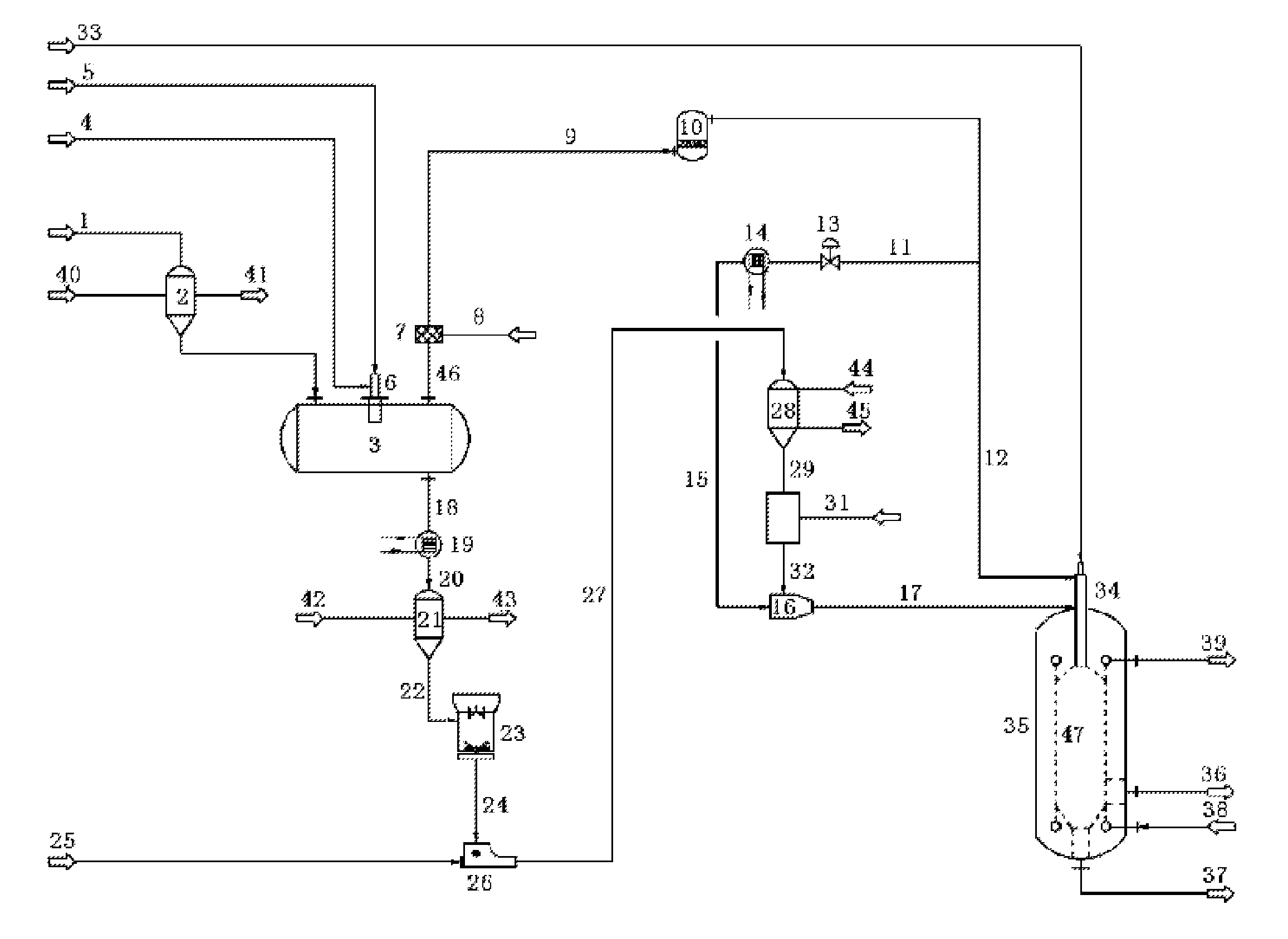Method and system for producing synthetic gas from biomass by high temperature gasification
a high temperature gasification and biomass technology, applied in the field of synthetic gas production, can solve the problems of poor heat exchange effect, large amount of tar, low heating value of synthetic gas, etc., and achieve the effect of reducing the temperature of the burner nozzle, reducing the heating rate and improving the working efficiency of the system
- Summary
- Abstract
- Description
- Claims
- Application Information
AI Technical Summary
Benefits of technology
Problems solved by technology
Method used
Image
Examples
example 1
[0043]Take wood as a raw material of biomass. The elemental composition and characteristic data of the dried wood are listed in Table 1.
TABLE 1Elemental composition and characteristic data of the dried woodItemsSymbolUnitValueCarbonCar%(Kg / Kg)39.43HydrogenHar%(Kg / Kg)5.21OxygenOar%(Kg / Kg)38.36NitrogenNar%(Kg / Kg)0.15SulfurSar%(Kg / Kg)0.21ChlorineClar%(Kg / Kg)0.00AshAar%(Kg / Kg)5.00MoistureMar%(Kg / Kg)11.64Ash fusion pointFT° C.1436Low heat valueLHVMJ / Kg14.75
[0044]Take natural gas as external combustible gas. The elemental composition and characteristic data of the external combustible gas are listed in Table 2.
TABLE 2Components and characteristic data of natural gasComponentsValueCH491.746%C2H64.480%C3H82.257%CO20.070%O20.040%N21.406%H2S concentration (mg / Nm3)20.00Low heat value (kcal / m3)9000.8
[0045]The main operating conditions are set as follows:
[0046]1) The transportation amount of biomass into the carbonization furnace 3 via the supercharging feeding system of biomass 2 is 4.07 kg / s.
[...
example 2
[0067]Take wood as a raw material of biomass (as shown in Table 1). Take natural gas as external combustible gas (as shown in Table 2). The temperature of the carbonization furnace 3 is 600° C. The heating rate of pyrolysis of the biomass in the carbonization furnace 3 is 100° C. / s. Other operating conditions are the same as that in Example 1.
[0068]Based on the above conditions, the main flow rate and performance parameters of the system are as follows:
[0069]1) The mass flow rate of the external combustible gas (40° C.) entering the carbonization furnace 3 is 0.33 Kg / s.
[0070]2) The mass flow rate of the external oxygen (160° C.) entering the carbonization furnace 3 is 0.63 Kg / s.
[0071]3) The flame temperature of the burner nozzle 6 of the carbonization furnace 3 is 1700° C.
[0072]4) The total weight of the pyrolysis gas produced in the carbonization furnace 3 is 3.84 Kg / s.
[0073]5) The total weight of the charcoal produced in the carbonization furnace 3 is 1.19 Kg / s.
[0074]6) The combus...
example 3
[0081]Take wood as a raw material of biomass (as shown in Table 1). Take natural gas as the external combustible gas (as shown in Table 2). The input amount of the external combustible gas (mole) is 5 times that required for a complete combustion with the input oxygen. Other operating conditions are the same as that in Example 1.
[0082]Based on the above conditions, the main flow rate and performance parameters of the system are as follows:
[0083]1) The mass flow rate of the external combustible gas (40° C.) entering the carbonization furnace 3 is 0.78 Kg / s.
[0084]2) The mass flow rate of the external oxygen (160° C.) entering the carbonization furnace 3 is 0.604 Kg / s.
[0085]3) The flame temperature of the burner nozzle 6 of the carbonization furnace 3 is 1200° C.
[0086]4) The total weight of the pyrolysis gas produced in the carbonization furnace 3 is 4.3 Kg / s.
[0087]5) The total weight of the charcoal produced in the carbonization furnace 3 is 1.19 Kg / s.
[0088]6) The combustible gas whic...
PUM
 Login to View More
Login to View More Abstract
Description
Claims
Application Information
 Login to View More
Login to View More - R&D
- Intellectual Property
- Life Sciences
- Materials
- Tech Scout
- Unparalleled Data Quality
- Higher Quality Content
- 60% Fewer Hallucinations
Browse by: Latest US Patents, China's latest patents, Technical Efficacy Thesaurus, Application Domain, Technology Topic, Popular Technical Reports.
© 2025 PatSnap. All rights reserved.Legal|Privacy policy|Modern Slavery Act Transparency Statement|Sitemap|About US| Contact US: help@patsnap.com


